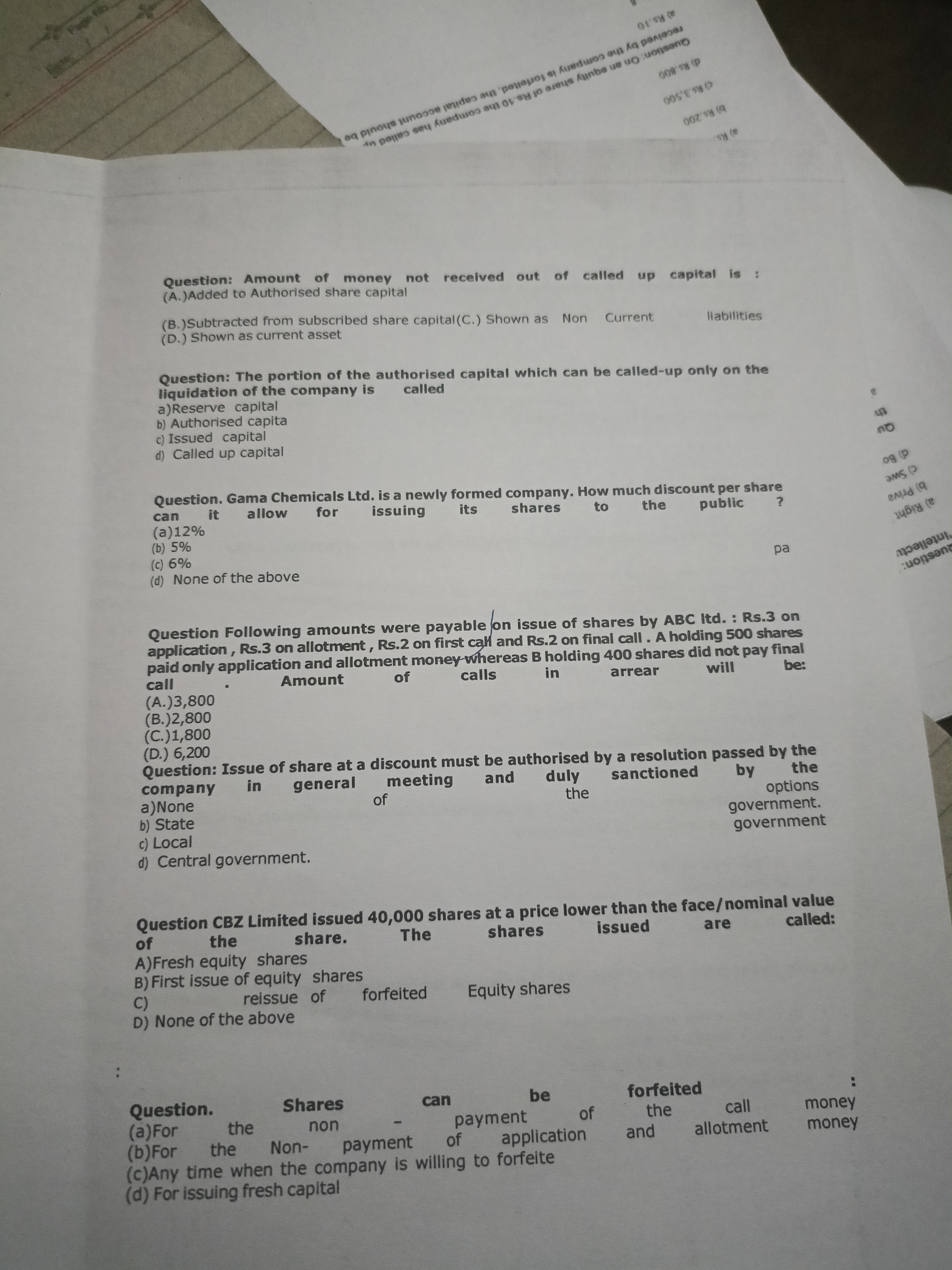1. Amount of money not received out of called up capital is: (A) Added to Authorised share capital (B) Subtracted from subscribed share capital (C) Shown as Non Current liabilit... 1. Amount of money not received out of called up capital is: (A) Added to Authorised share capital (B) Subtracted from subscribed share capital (C) Shown as Non Current liabilities (D) Shown as current asset. 2. The portion of the authorised capital which can be called-up only on the liquidation of the company is called: (A) Reserve capital (B) Authorised capital (C) Issued capital (D) Called up capital. 3. Gama Chemicals Ltd. is a newly formed company. How much discount per share can it allow for issuing its shares to the public? (A) 12% (B) 5% (C) 6% (D) None of the above. 4. Following amounts were payable on issue of shares by ABC ltd.: Rs.3 on application, Rs.3 on allotment, Rs.2 on first call and Rs.2 on final call. A holding of 500 shares did not pay final call. Amount of calls in arrear will be: (A) 3,800 (B) 2,800 (C) 1,800 (D) 6,200. 5. Issue of share at a discount must be authorised by a resolution passed by the company in general meeting and duly sanctioned by the: (A) None of the government options (B) State (C) Local (D) Central government. 6. CBZ Limited issued 40,000 shares at a price lower than the face/nominal value of the share. The shares issued are called: (A) Fresh equity shares (B) First issue of equity shares (C) Reissue of forfeited equity shares (D) None of the above. 7. Shares can be forfeited for: (A) For the non-payment of the call money (B) For the non-payment of application and allotment money (C) Any time when the company is willing to forfeit (D) For issuing fresh capital.

Understand the Problem
The question set consists of multiple choice questions related to company finance, specifically regarding share capital, issued shares, and associated financial concepts. The user may be seeking answers to these questions or explanations of the concepts involved.
Answer
1. Subtracted from subscribed share capital. 2. Reserve capital. 3. None. 4. 1,800. 5. Central. 6. Reissue. 7. Non-payment of the call money.
- Subtracted from subscribed share capital. 2. Reserve capital. 3. None of the above. 4. 1,800. 5. Central government. 6. Reissue of forfeited equity shares. 7. For the non-payment of the call money.
Answer for screen readers
- Subtracted from subscribed share capital. 2. Reserve capital. 3. None of the above. 4. 1,800. 5. Central government. 6. Reissue of forfeited equity shares. 7. For the non-payment of the call money.
More Information
In accounting for share capital, understanding terms like called-up capital, reserve capital, and calls in arrear is important for financial management. Companies are legally bound in how they can issue shares, especially at a discount.
Tips
A common mistake is confusing the terms related to share capital, particularly when dealing with unpaid amounts and share issuance.
Sources
- NCERT Solution for Class 12 Accountancy Chapter 1 - BYJU'S - byjus.com
- Amount of money not received out of called up capital is - Doubtnut - doubtnut.com
- [PDF] Accounting for Share Capital - NCERT - ncert.nic.in
AI-generated content may contain errors. Please verify critical information